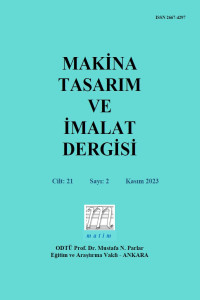Öz
Tornalama işlemlerinde takım aşınmasının gerçek zamanlı takibiyle, kesici takımı daha verimli kullanmak ve aşınmaya bağlı ölçü/tolerans ve yüzey hatalarını en aza indirmek mümkün olabilir. Tornalanmış yüzey imgeleri üzerinden yanak aşınmasına dair bir çıkarım ve tahminde bulunmak mevcut yöntemlere bir alternatif olarak bir çok araştırmacı tarafından çalışılmaktadır. Bu çalışmada aşınmaya bağlı parlaklık değişiminin gözlemlenmesi amacı ile tornalanmış yüzey imgeleri gri ton ortalamaları bir öznitelik olarak çıkarılmış ve aşınma ile uyum istatistikleri incelenmiştir. Farklı kesme parametreleri ile gerçekleştirilen deneyler sonrası aşınma ile gri ton ortalamaları arasında düşük uyumlu fakat dinamik olarak benzer bir değişim bulunmuştur.
Anahtar Kelimeler
Kaynakça
- 1. Nath, C., “Integrated Tool Condition Monitoring Systems and Their Applications: A Comprehensive Review”, Procedia Manufacturing, 2020, Volume 48, pp. 852-863.
- 2. Mohamed, A., Hassan, M., M’Saoubi, R., Attia, H., “Tool Condition Monitoring for High-Performance Machining Systems—A Review.”, Sensors 2022, 22, 2206.
- 3. Li, X., Liu, X., Yue, C., Liang, S.,Y., Wang, L.,“Systematic review on tool breakage monitoring techniques in machining operations,”, International Journal of Machine Tools and Manufacture,2022, Volume 176,103882.
- 4. Kassim, A., Mannan, M., Jing, M. “Machine tool condition monitoring using workpiece surface texture analysis.”, Machine Vision and Applications, 2000, vol. 11, pp. 257–263.
- 5. Ratnam, M.,M., “Factors Affecting Surface Roughness in Finish Turning”, Comprehensive Materials Finishing, 2017, vol. 1, pp. 1-25.
- 6. Ramamoorthy, B., Radhakrishnan, V., “Statistical approaches to surface texture classification”, Wear,1993, vol.167, pp.155-161.
- 7. Kassim, A.,A., Mannan, M.,A., ve Mian, Z.,” Texture analysis methods for tool condition monitoring”, Image and Vision Computing, 2007, vol. 25, pp. 1080-1090. 8. Diaz-Saldaña, G., Osornio-Rios, R.A., Cruz-Albarran, I.A., Trejo-Hernandez, M. and Antonino-Daviu, J.A., 2022, October. CNC lathe tool wear analysis using image processing and stray flux. In IECON 2022–48th Annual Conference of the IEEE Industrial Electronics Society (pp. 1-6). IEEE.
- 9. Dutta, S., Pal, S.K. and Sen, R., 2016. Tool condition monitoring in turning by applying machine vision. Journal of Manufacturing Science and Engineering, 138(5). 10. Bhat, N.N., Dutta, S., Pal, S.K. and Pal, S., 2016. Tool condition classification in turning process using hidden Markov model based on texture analysis of machined surface images. Measurement, 90, pp.500-509.
- 11. Datta, A., Dutta, S., Pal, S.K. and Sen, R., 2013. Progressive cutting tool wear detection from machined surface images using Voronoi tessellation method. Journal of Materials Processing Technology, 213(12), pp.2339-2349.
- 12. Küllaç, M.T. and Çuvalcı, O., 2023. Correlation statistics of a Fourier transform feature with flank wear on different sections of turned surface images for real time monitoring applications. Measurement, 207, p.112399.
- 13. Das, S.R., Dhupal, D., Kumar, A., Study of surface roughness and flank wear in hard turning of aisi 4140 steel with coated ceramic inserts, J. Mech. Sci. Technol. 29 (10) (2015) 4329–4340.
Investigation of the relationship between the gray scale average values of turned surface images and tool wear
Öz
With real-time monitoring of tool wear in turning operations, it may be possible to use the cutting tool more efficiently and to minimize wear-related size/tolerance and surface errors. Inference and estimation of flank wear from turned surface images has been studied by many researchers as an alternative to existing methods. In this study, the gray tone averages of the turned surface images were extracted as a feature in order to observe the change in reflectivity due to wear, and the wear and correlation statistics were examined. After experiments with different cutting parameters, a low correlate but dynamically similar change was found between wear and gray tone averages.
Anahtar Kelimeler
Kaynakça
- 1. Nath, C., “Integrated Tool Condition Monitoring Systems and Their Applications: A Comprehensive Review”, Procedia Manufacturing, 2020, Volume 48, pp. 852-863.
- 2. Mohamed, A., Hassan, M., M’Saoubi, R., Attia, H., “Tool Condition Monitoring for High-Performance Machining Systems—A Review.”, Sensors 2022, 22, 2206.
- 3. Li, X., Liu, X., Yue, C., Liang, S.,Y., Wang, L.,“Systematic review on tool breakage monitoring techniques in machining operations,”, International Journal of Machine Tools and Manufacture,2022, Volume 176,103882.
- 4. Kassim, A., Mannan, M., Jing, M. “Machine tool condition monitoring using workpiece surface texture analysis.”, Machine Vision and Applications, 2000, vol. 11, pp. 257–263.
- 5. Ratnam, M.,M., “Factors Affecting Surface Roughness in Finish Turning”, Comprehensive Materials Finishing, 2017, vol. 1, pp. 1-25.
- 6. Ramamoorthy, B., Radhakrishnan, V., “Statistical approaches to surface texture classification”, Wear,1993, vol.167, pp.155-161.
- 7. Kassim, A.,A., Mannan, M.,A., ve Mian, Z.,” Texture analysis methods for tool condition monitoring”, Image and Vision Computing, 2007, vol. 25, pp. 1080-1090. 8. Diaz-Saldaña, G., Osornio-Rios, R.A., Cruz-Albarran, I.A., Trejo-Hernandez, M. and Antonino-Daviu, J.A., 2022, October. CNC lathe tool wear analysis using image processing and stray flux. In IECON 2022–48th Annual Conference of the IEEE Industrial Electronics Society (pp. 1-6). IEEE.
- 9. Dutta, S., Pal, S.K. and Sen, R., 2016. Tool condition monitoring in turning by applying machine vision. Journal of Manufacturing Science and Engineering, 138(5). 10. Bhat, N.N., Dutta, S., Pal, S.K. and Pal, S., 2016. Tool condition classification in turning process using hidden Markov model based on texture analysis of machined surface images. Measurement, 90, pp.500-509.
- 11. Datta, A., Dutta, S., Pal, S.K. and Sen, R., 2013. Progressive cutting tool wear detection from machined surface images using Voronoi tessellation method. Journal of Materials Processing Technology, 213(12), pp.2339-2349.
- 12. Küllaç, M.T. and Çuvalcı, O., 2023. Correlation statistics of a Fourier transform feature with flank wear on different sections of turned surface images for real time monitoring applications. Measurement, 207, p.112399.
- 13. Das, S.R., Dhupal, D., Kumar, A., Study of surface roughness and flank wear in hard turning of aisi 4140 steel with coated ceramic inserts, J. Mech. Sci. Technol. 29 (10) (2015) 4329–4340.
Ayrıntılar
| Birincil Dil | Türkçe |
|---|---|
| Konular | Makine Mühendisliği |
| Bölüm | Araştırma, Geliştirme ve Uygulama Makaleleri |
| Yazarlar | |
| Yayımlanma Tarihi | 24 Kasım 2023 |
| Gönderilme Tarihi | 22 Mart 2023 |
| Yayımlandığı Sayı | Yıl 2023 Cilt: 21 Sayı: 2 |


